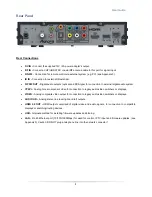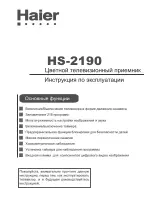
18
User Guide
APPENDIX 2 RF System Guidelines
This section is a basic guideline based on the SCTE Digital Cable Network Standard. For optimal performance on a
cable system following the published standards will usually lead to the best results and the least headaches. More
detailed documents are available from the standards committees.
Analog and Digital Channel: RF Transmission Characteristics
1. RF Channel Spacing 6 MHz
2. RF Frequency Range 54 MHz to 864 MHz IRC/HRC/Standard Channel Plans.
3. Transit delay from headend to most distant customer < 0.800 msec (typically much less)
4. Carrier-to-noise ratio, C/(N+I), in a 6-MHz band where C/(N+I) includes the simultaneous presence of all additive
impairments in the 6-MHz channel bandwidth including CTB, CSO, other
discrete interference.
C/N (analog channels)
Not less than
27 dB for 64 QAM;
33 dB for 256 QAM;
43 dB for AM-VSB analog
5. CTB Not worse than -53 dBc referenced to inband carrier levels for analog channels.
6. CSO Not worse than -53 dBc referenced to inband carrier levels for analog channels.
7. Carrier-to-any other discrete interference (ingress) Not worse than -53 dBc
8. AM Hum Modulation Not greater than 3% p-p
9. Group Delay Variation < 0.25 µsec/MHz across the 6-MHz channel
10. Chroma / Luma Delay ≤ 170 ns (AM-VSB analog)
11. Phase Noise < -88 dB/Hz @ 10 kHz offset (relative to the center of QAM signal spectrum)
12. Maximum amplitude variation across the 6-MHz channel (digital channels)
Maximum amplitude variation across the 6-MHz channel (analog channels) < 5 dB p-
p ≤ 4 dB p-p
13. Micro-reflections bound for dominant echo
-10 dB at < 0.5 µs
-15 dB at < 1.0 µs
-20 dB at < 1.5 µs
-30 dB at < 4.5 µs












































